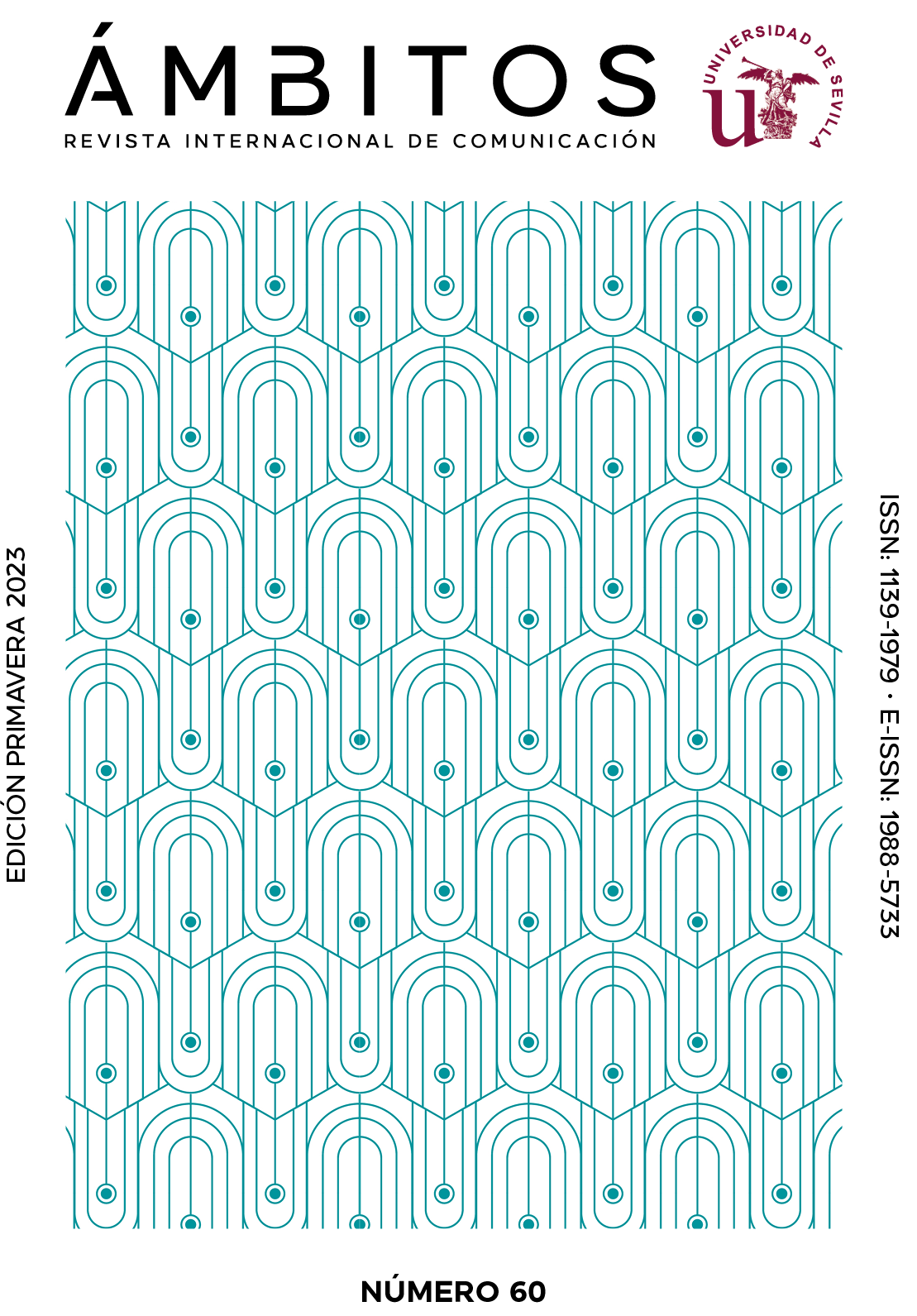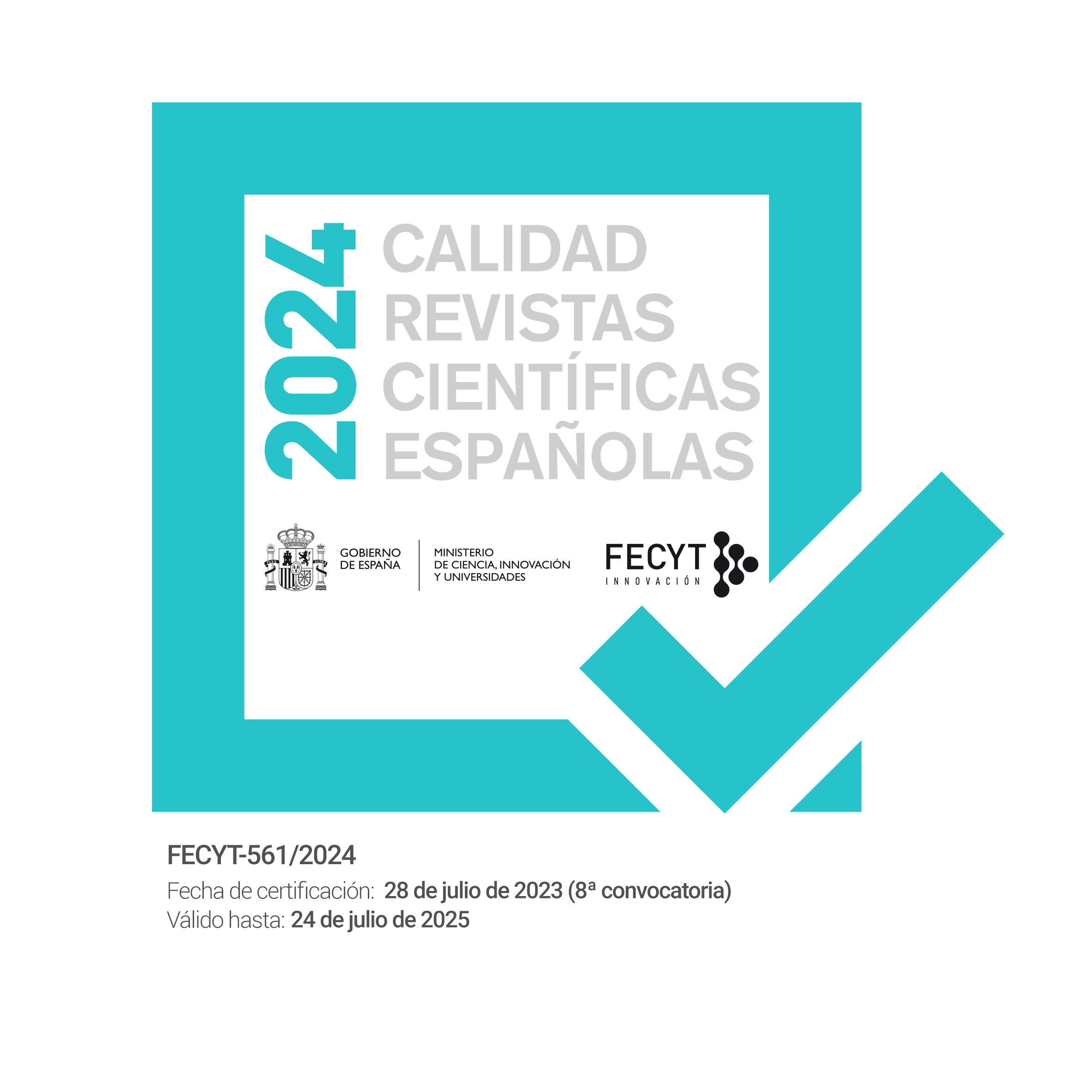Mediação parental no uso do YouTube: Um estudo de caso no Brasil
DOI:
https://doi.org/10.12795/Ambitos.2023.i60.09Palabras clave:
crianças, nativos digitais, mediação parental, YoutubeResumen
Este estudo de caso teve o objetivo de compreender de que maneira as famílias se portam mediante o consumo de conteúdo das (os) filhas (os) na plataforma YouTube. Trata-se de uma pesquisa descritiva quantitativa. A coleta de dados foi realizada por meio de um questionário on-line que foi aplicado a pais de alunos de colégios públicos e particulares da cidade de Poços de Caldas, em Minas de Gerais, no Brasil. Como referencial teórico, discutiu-se a presença da infância nos meios digitais na contemporaneidade, por meio do comportamento das crianças descritas com base nos direcionamentos de Tomé e Borges (2019), dada a relevância em desvendar de que modo os pais monitoram e medeiam este processo; assim como os estilos parentais de Baumrind (1991), no sentido de identificar qual tipo de comportamento dos responsáveis foi mais presente entre as respostas e resultados elucidados. Além disso, discutiu-se a necessidade do desenvolvimento de competências midiáticas por parte das crianças com base em Potter (2015). Partiu-se da hipótese de que haveria diferenças na mediação e estilos parentais a partir de questões socioeconômicas e de gênero. A análise estatística dos dados e das variáveis mostrou que a principal diferença na mediação está relacionada ao gênero: já que as mães possuem maior participação na mediação das crianças e se caracterizam por administrar uma responsabilidade simbólica acerca do comportamento delas na plataforma; enquanto os pais possuem uma responsabilidade material no sentido de fornecer às (aos) filhas (os) dispositivos tecnológicos digitais que lhes permitem acessar e navegar pela rede.
Descargas
Citas
Agência Brasil (2021, 25 noviembre). Estudo mostra que pandemia intensificou uso das tecnologias digitais. https://bit.ly/3LdI6bt
Araujo, D. K. (2019). Entre “likes” e postagens: Conteúdos acessados e veiculados no YouTube por crianças do 4º ano dos Anos Iniciais do Ensino Fundamental. Trabalho de Conclusão de Curso apresentado ao Curso de Pedagogia da Universidade Federal da Paraíba. https://bit.ly/3J8kh1P
Barbosa-da-Silva, M., Borges, G., Fantin, M., Almeida Pimenta, M. A., & Aguaded, I. (2021). Competência midiática em crianças de 9 a 12 anos em cenários brasileiros. Intercom: Revista Brasileira De Ciências Da Comunicação, 44(1), 21-45.
https://doi.org/10.1590/1809-5844202111
Baumrind, D. (1991). The influence of pareting style on adolescent competence and substance use. The Journal of Early Adolescence, 11(1), 56-95.
https://doi.org/10.1177/0272431691111004
Beiguelman, G. (2021). Políticas da imagem: vigilância e resistência na dadosfera. Ubu.
Brito, R. (2018). Estilos de mediação do uso de tecnologias digitais por crianças até aos 6 anos. Da Investigação às Práticas, 8(2), 21-46.
https://doi.org/10.25757/invep.v8i2.155
Brito, R., & Dias, P. (2017). Crianças até 8 anos e Tecnologias Digitais no Lar: Os pais como modelos, protetores, supervisores e companheiros. Observatorio (OBS*), 11(2), 72–90.
https://doi.org/10.15847/obsOBS11220171072
Böing, E., & Crepaldi, M. (2016). Relação pais e filhos: Compreendendo o interjogo das relações parentais e coparentais. Educar em Revista, 32(59), 17–33.
https://doi.org/10.1590/0104-4060.44615
Carlson, L., Laczniak, R. N., & Wertley, C. (2011). Parental style: The implications of what we know (and Think we Know). Journal of Advertising Research, 51(2), 427–435.
https://doi.org/10.2501/JAR-51-2-427-435
Cardoso, J., & Verissimo, M. (2013). Estilos parentais e relações de vinculação. Análise Psicológica, 31(4), 393–406. https://bit.ly/3T3NYWC
Castro, T. S. (2021). Cuidado com quem você fala na internet: Medicação parental pelo olhar de pré-adolescentes. Cadernos CEDES, 41(113), 4–13.
https://doi.org/10.1590/cc231361
Clark, L. S. (2011). Parental Mediation Theory for the Digital Age. Communication Theory, 21(4), 323–343.
https://doi.org/10.1111/j.1468-2885.2011.01391.x
Creswell, J. W. (1998). Qualitative inquiry and research design: choosing among five traditions. Sage.
Delgado-Ponce, A. y Pérez-Rodrigues, M. A. (2018). La competencia mediática. En R. García-Ruiz, A. Pérez-Rodríguez y A. Torres (Eds.), Educar para los nuevos medios (pp. 13–25). Editorial Universitaria Abya-Yala. https://dspace.ups.edu.ec/handle/123456789/17049
Estatuto da Crianca e do Adolescente, Lei 8.069 – 1990 (2009). Lamparina.
Ferraz, A. R. da R. S. (2019). A utilização da internet feita por crianças com idade entre 5 e 10 anos. Universidade Federal de Alagoas. https://bit.ly/3Jaf6OY
Ferreira, J. E. H. Mc. (2013). O papel da criança no processo de compra da família [Dissertação de mestrado]. Universidade do Algarve. https://bit.ly/3YEGrPd
Ferrés, J. y Piscitelli, A. (2012). La competencia mediática: Propuesta articulada de dimensiones e indicadores. Comunicar, 19(38), 75–82.
https://doi.org/10.3916/C38-2012-02-08
Fontenelle, L. (2015). A onipresente publicidade infantil na internet. Outras palavras, jornalismo de profundidade e pós-capitalismo. https://bit.ly/3LhvFv5
Gonçalves, M. C. (2009). Propaganda e Publicidade. IESDE Brasil. https://bityli.com/zNCcj8
Grizólio, T. C., & Scorsolini-Comin, F. (2020). Como a mediação parental tem orientado o uso de internet do público infanto-juvenil? Psicologia Escolar e Educacional, 24.
https://doi.org/10.1590/2175-35392020217310
Lee, S. J., & Chae, Y. G. (2007). Children’s Internet use in a family context: Influence on family relationships and parental mediation. Cyberpsychology & Behavior, 10(5), 640–644.
https://doi.org/10.1089/cpb.2007.9975
Livingstone, S., & Bober, M. (2004). UK children Go Online: Surveying the experiences of young people and their parents. London School of Economics and Political Science. http://eprints.lse.ac.uk/395/
MacGill, A. (2007, 24 outubro). Parent and Teen Internet Use. Pew Research Center. https://pewrsr.ch/3YIxxzX
Maidel, S., & Vieira, L. M. (2015). Mediação parental do uso da internet pelas crianças. Psicologia em Revista, 21(2), 293–313.
Mondin, E. M. C. (2008). Práticas educativas parentais e seus efeitos na criação dos filhos. Psicologia Argumento, 26(54), 233–244. https://periodicos.pucpr.br/psicologiaargumento/article/view/19885
Nathanson, A. I. (1999). Identifying and Explaining the Relationship Between Parental Mediation and Children’s Aggression. Communication Research, 26(2), 124–143.
https://doi.org/10.1177/009365099026002002
Passarelli, B., Junqueira, A. H., & Angeluci, A. C. B. (2014). Os nativos digitais no Brasil e seus comportamentos diante das telas. Matrizes, 8(1), 159–178.
https://doi.org/10.11606/issn.1982-8160.v8i1p159-178
Paiva, R. N. de, Kanai, J., & Fontanini, P. S. P. (2020). Um estudo de gestão de facilidades em um campus sustentável baseado em internet das coisas e inteligência ambiental. Encontro Nacional de Tecnologia do Ambiente Construído, 18(1), 1–8.
https://doi.org/10.46421/entac.v18i.1016
Prensky, M. (2001). Digital Natives, Digital Immigrants Part 1. On the horizon, 9(5), 1-6.
https://doi.org/10.1108/10748120110424816
Potter, W. J. (2015). Introduction to Media Literacy. SAGE Publications.
Potter, W. J., & Riddle, K. (2007). A content analysis of the media effects literature. Journalism & Mass Communication Quarterly, 84(1), 90-104.
https://doi.org/10.1177/107769900708400107
Schmidt, S. (2012). Mídia e consumo infantil: Um desafio da comunicação e educação. IX ANPED Sul. Seminário de pesquisa em educação da região sul.
Serrão, B. O., Sarmento, M. J., & Santana, J. P. (2022). O ativismo digital das crianças em tempos de pandemia. Educação & Sociedade, 43.
https://doi.org/10.1590/es.257004
Sobchack, V. (1994). The scene of the screen: envisioning cinematic and electronic “presence”. In H. U. Gumbrecht & K. L. Pfeiffer (Eds.), Materialites of communication (pp. 83–106). Stanford University Press.
Tomé, H. L., & Borges, G. (2019). A infância no YouTube: uma análise da produção de conteúdo do canal “Planeta das Gêmeas”. XXIV Congresso de Ciências da Comunicação na Região Sudeste – Vitória. https://bit.ly/3FcZB7M
Yin, R. K. (2005). Estudos de caso: Planejamento e métodos. Bookman.
Publicado
Cómo citar
Número
Sección
Licencia
Derechos de autor 2023 Diego de Deus, Laura Amorim, Adinan Nogueira, Carolina Soares, Julia Oliveira

Esta obra está bajo una licencia internacional Creative Commons Atribución-NoComercial-CompartirIgual 4.0.
Ámbitos. Revista Internacional de Comunicación es una revista de acceso abierto, lo que significa que todo su contenido está disponible gratuitamente para el usuario o su institución. Los usuarios pueden leer, descargar, copiar, distribuir, imprimir, buscar o enlazar con el texto completo de los artículos, o utilizarlos para cualquier otro fin lícito, sin solicitar permiso previo al editor o al autor. Esta definición de acceso abierto se ajusta a la Iniciativa de Acceso Abierto de Budapest (BOAI).

A menos que se indique lo contrario, todo el contenido de la edición electrónica se distribuye bajo una " licencia internacional Creative Commons Attribution-NonCommercial-ShareAlike 4.0 ". Puede consultar la versión informativa y el texto legal de la licencia aquí. Esto debe indicarse expresamente de esta manera cuando sea necesario.
En caso de aceptación del manuscrito, los autores ceden los derechos de la obra para su publicación a Ámbitos. Revista Internacional de Comunicación bajo el contrato de licencia Reconocimiento-NoComercial-CompartirIgual 4.0 Internacional (CC BY-NC-SA 4.0). Los autores conservan los derechos de autor y terceros están autorizados a copiar, distribuir y hacer uso de la obra, siempre que cumplan con los términos y condiciones establecidos en la licencia.
- Citar la autoría y la fuente original de publicación (revista, editorial y URL de la obra).
- No los utilice con fines comerciales.
- Si remezcla, transforma o crea a partir del material, debe publicar sus contribuciones bajo la misma licencia que el original.
Se puede encontrar más información en https://creativecommons.org/licenses/by-nc-sa/4.0/deed.es



















